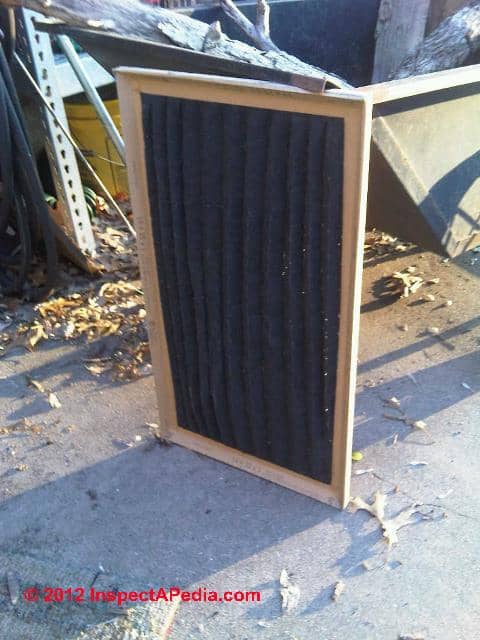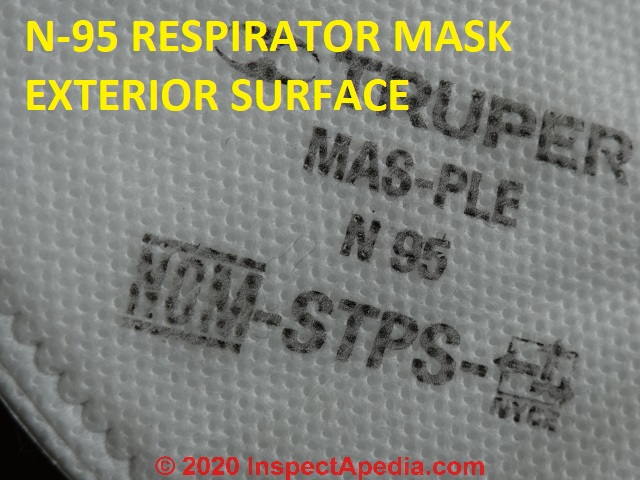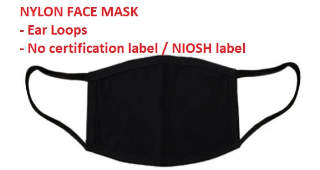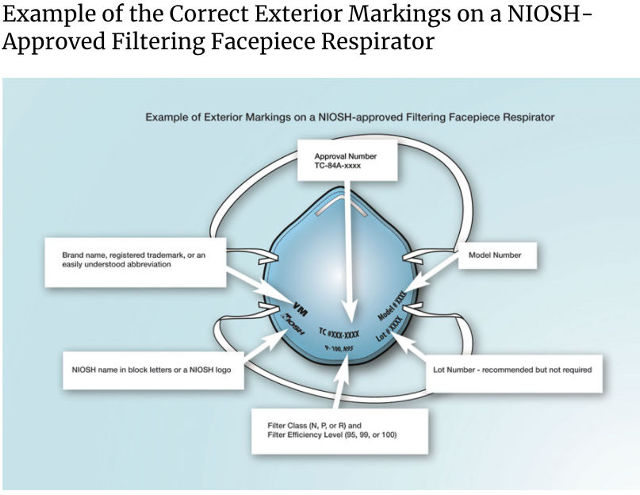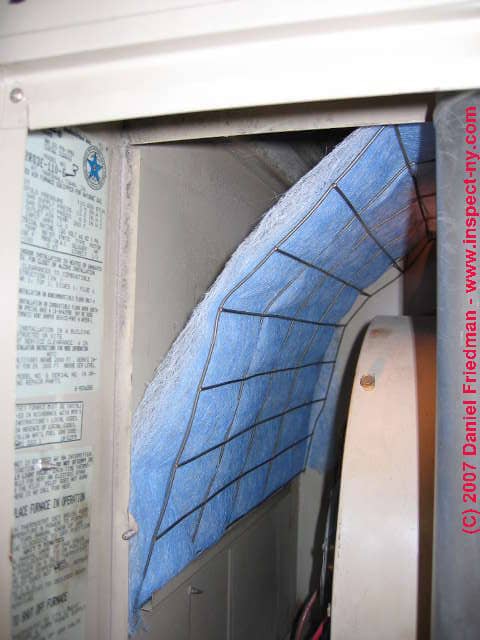 Use Air Filter Material to Make COVID-19 Face Masks
Use Air Filter Material to Make COVID-19 Face Masks
HEPA & MERV Ratings,
Material thickness,
Emergency face
mask re-use
- POST a QUESTION or COMMENT about using HVAC air filters for home-made face masks
Q&A about using heating or air condoning system air filter materials to make a face mask for general (non-medical) use during the COVID-19 pandemic.
This article describes types of air filters for HVAC systems and outlines properties including filtration level or efficiency and material thickness and pliability and thus its suitability for making an emergency-use face mask as a more-effective alternative to simple cloth face masks.
InspectAPedia tolerates no conflicts of interest. We have no relationship with advertisers, products, or services discussed at this website.
- Daniel Friedman, Publisher/Editor/Author - See WHO ARE WE?
Air filter materials re-purposed to make face masks?
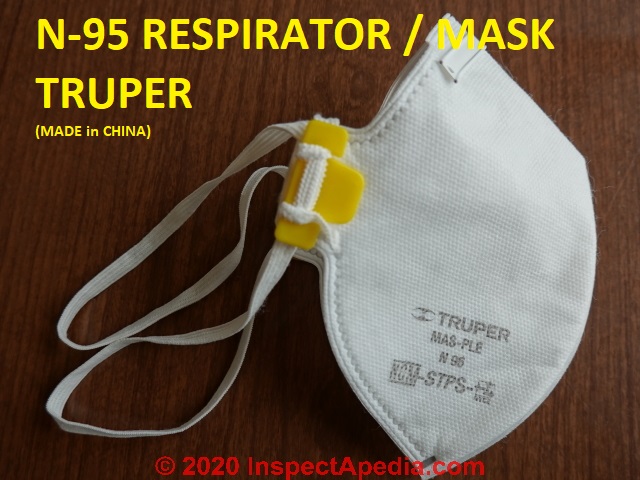 Preserve medical-grade masks for health care workers who desperately need them at a time when they are in continuously short supply.
Preserve medical-grade masks for health care workers who desperately need them at a time when they are in continuously short supply.
Watch out:
The excerpting from The New York Times, the World Health Organization and the CDC,
It is important to preserve medical-grade masks for health care workers who desperately need them at a time when they are in continuously short supply.
Masks don’t replace hand washing and social distancing.
Article Index
- AIR FILTER MATERIAL RE-PURPOSED for FACE MASKS - you are on this page
- MERV RATING for AIR FILTERS RE-PURPOSED for FACE MASKS
- MERV RATING for HEPA FILTERS
- COMMON MISTAKES in DIY FACE MASKS / RESPIRATORS
- RECOMMENDED FILTER MATERIALS for DIY RESPIRATORS / FACE MASKS
- CLOTH FACE MASK ADVICE
- WHICH FILTER SIDE OUT for DIY RESPIRATORS?
- FAKE or COUNTERFEIT RESPIRATOR / MASK WARNINGS
- RE-USE GUIDELINES for RESPIRATORS / FACE MASKS
What MERV means when buying air filter for re-purposing for DIY face masks
MERV is an acronym for "Minimum Efficiency Reporting Value".
The MERV rating on an air filter describes its efficiency as a means of reducing the level of 0.3 to 10 micron-sized particles in air which passes through the filter. Higher "MERV" means higher filter efficiency.
The purpose of the MERV standard is to permit an "apples to apples" comparison of the filtering efficiency of various air filters.
Don't expect the thin washable plastic air filters used on window or split system or portable air conditioners (shown at left) to operate with the same efficiency as more sophisticated filters.
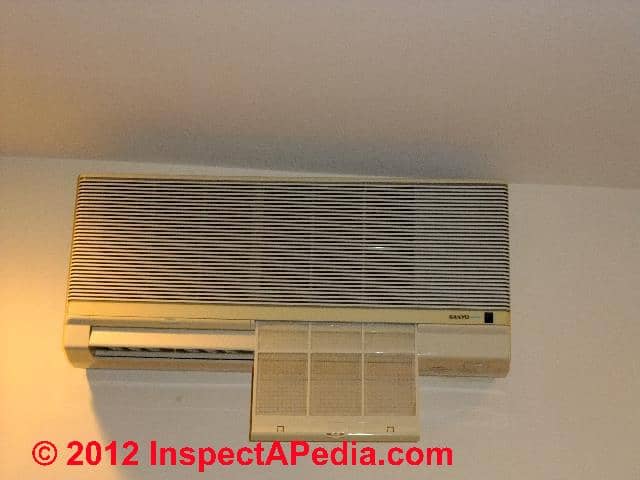 Al Veeck, executive director of the National Air Filter Association has pointed out that MERV includes a broad range of small airborne particles described in 3 ranges:
Al Veeck, executive director of the National Air Filter Association has pointed out that MERV includes a broad range of small airborne particles described in 3 ranges:
- E1 - 0.3 to 1.0 micrometers - this is the level of filtration that's needed to reduce exposure to viruses such as COVID-19
- E2 - 1.0 to 3.0 micrometers
- E3 - 3.0 to 10 micrometers
An air filter that is effective within the range of 0.3u to 10u will collect even the smallest mold spores (such as Aspergillus sp. & Penicillium sp. and larger particles such as pollen, and upwards to fiberglass insulation fragments.
Air filter efficiency
refers to the relative ability of a filter to remove particles of a given size or size range from air passing through the filter.
If a filter were 100% efficient, none of the particles in a given size range would escape the filter and air which has passed through such a filter would contain zero particles.
Also see AIR FLOW RATE TYPICAL CFM Specifications for HVAC equipment.
MERV "Ratings":
Mr. Veeck also points out that MERV is a reporting value, not a filter rating value, although we find frequent referrals to "MERV Ratings" in various publications, including a Wikipedia entry on this topic.
The MERV Efficiency Rating [reporting] Scale
ranges from 1 to 16, with 1 being the lowest efficiency and 16 describing the highest efficiency. The particle size range addressed by the MERV scale is 3 to 10 microns.
A logical inference is that if an air filter is removing particles down to 0.3 - 10 microns, it is certainly also at least that efficient at removing larger sized particles.
Typical air filter material MERV Ratings
A very low-cost disposable fiberglass furnace filter may have a MERV rating of 1 to 4 - pretty low.
Low MERV-rated air filter materials probably perform no better than a cotton cloth when being re-purposed as an N-95 face mask "substitute".
A high-MERV-rated material in the range of MERV 12 and above is far more effective, but you will need to make a closer examination of the air filter material to be sure that it is not too thick or dense to use as a face mask: too-thick or too-dense a mask can be so difficult to breathe-through that it may be unsafe for the wearer.
Examples of specific air filters and their efficiency are
at AIR FILTERS, OPTIMUM INDOOR
and at CASCADED AIR FILTERS
A medium efficiency MERV pleated air filter
in the range of MERV 5-13 is, according to the US EPA, reasonably efficient at removing small to large airborne particles.
EPA also opines that: "Filters with a MERV 7-13 are likely to be nearly as effective as true HEPA filters at controlling most airborne indoor particles."
We can't explain the overlap of these two statements except to speculate that the EPA writer was thinking that the MERV of an air filter is not constant - particle filtration improves as the filter gets dirtier.
EPA adds that medium efficiency air filters are generally less expensive than HEPA filters, and allow quieter HVAC fan operation and higher airflow rates than HEPA filters since they have less airflow resistance.
A high efficiency high MERV pleated air filter
in the MERV 13-16 range would be expected to remove smaller particles between 0.3u and 1.0u in size at about a 75% efficiency.
But before getting too excited about 75% looking not as good at 99.97% (see HEPA filtration discussed below) remember that in a heating or air conditioning system air is being recirculated through the filter system.
So if each pass is removing 75% of the particles we want to capture, over time the heating or air conditioning filter system will do a good job of removing a very large amount of airborne dust.
This is exactly what we saw when we tested some filtering approaches in our forensic laboratory. The longer we ran the air handler fan the more dramatically we saw the airborne dust level drop in the test area.
The US EPA points out that higher efficiency filters with a MERV of 14 to 16, sometimes misidentified as HEPA filters, are similar in appearance to true HEPA filters, which have MERV values of 17 to 20. As you'll read below, you may not want to rush to install a HEPA filter on your central air conditioner or heating system.
What is a HEPA Filter?
The Definition of A "HEPA" rated air filter:
a HEPA filter (High Efficiency Particulate Air [Filter] or better put, High Efficiency Particulate Arresting [Filter]) has to meet more demanding US DOE standards than a high MERV air filter.
True HEPA rated air filters have a MERV of 17-20.
A HEPA filter is required to remove at least 99.97% of airborne particles down to 0.3u in size (in diameter or in their longest dimension). Any filter, high MERV or HEPA, can be expected to filter out larger particles with an efficiency above its rating.
Zang, who has been investigating air pollution and defensive measures since at least 2014, along with others, recently investigated HVAC air filter effectiveness at filtering viral particles, selecting HVAC filtes classified as MERV 12 and higher, comparing MERV 12, MERV 13 and MERV 14 as those are commonly used in homes. They found that
High-efficiency residential HVAC filters were found to be effective at capturing airborne virus particles. (Zang 2020)
Watch out: however if you buy a high-MERV air filter and dis-assemble and/or modify it from its original form, you are changing its air filtering properties and probably it's capacity to trap viral particles.
Warnings when Making or Re-using an N95 Mask Substitute
- Air filter bypass leakage
if your face mask does not fit properly and tightly, no matter how efficient it is, it may be leaking a significant of air around itself at the mounting, reducing the overall effectiveness of the mask and thus the protection that it could provide. - Air filter density and reduction in airflow:
some air filters may be so dense that the cubic feet per minute of air that can pass through them is reduced drastically. Don't buy a material that is so thick that when made into a face mask the user will not be able to easily inhale sufficient air. - Mask Cleaning & Re-Use:
no face mask continues to be safe to use if it is dirty and contaminated. When re-using or extending the period of use of a face mask, some additional steps can improve its safety:
- Light spraying of the mask with a suitable disinfectant such as hydrogen peroxide or possibly alcohol (70-90%) and allowing the spray to dry thoroughly before re-use
- Allowing the mask to rest for 24 hours or longer
- Some sources recommend using a microwave oven to sterilize paper or cotton or air filter-made face masks. But
Watch out: the metal nose band or other metal components can not be placed in a microwave oven. Doing so risks both damage to the microwave itself as well as setting the mask materials on fire.
Also, some mask materials such as synthetic fabrics can melt and fuse if temperatures are too high. - Watch out: excerpting from The New York Times, the World Health Organization and the CDC,
It is important to preserve medical-grade masks for health care workers who desperately need them at a time when they are in continuously short supply.
Masks don’t replace hand washing and social distancing.
Research on HVAC Filters Effectiveness at Filtering Viruses
- CDC, US, STRATEGIES FOR OPTIMIZING THE SUPPLY OF FACEMASKS [PDF], U.S. Centers for Disease Control, retrieved 2020/07/14, original source: https://www.cdc.gov/coronavirus/2019-ncov/hcp/ppe-strategy/face-masks.html
- Livingston, Edward, Angel Desai, and Michael Berkwits. SOURCING PERSONAL PROTECTIVE EQUIPMENT DURING THE COVID-19 PANDEMIC, [PDF] Jama 323, no. 19 (2020): 1912-1914.
Excerpt: These and scores of other comments are insightful, many have references, provide links to websites and videos with illustration and instructions, and readers should spend time determining which, if any, might best fit their needs and situations. But the ingenuity displayed in the contributions needs to be placed in context. First, few of the ideas can be successful independent of the broader health care enterprise and its vulnerabilities. - Mohamed Hassan, M. D. "Standardized Synthesis of Face Masks as a Harm Reduction Strategy in Times of PPE Shortage-COVID-19, [PDF] (2020). Idaho STEM Action Center
802 West Bannock Street
Suite 900
Boise, Idaho, 83702
2020/07/14 NOTE: this article in its original web link had disappeared from https://stem.idaho.gov/
Here is an excerpt of its original text, possibly now withdrawn:
… Step 8 - Obtain a new furnace filter, and carefully strip off the cardboard frame … These filters are commonly used in HVAC systems and are readily available at most hardware stores … to compare filtration factor of a novel non-fit-tested high-efficiency particulate air (HEPA) filtering … - Mu, Quan, and Junjie Zhang. AIR POLLUTION AND DEFENSIVE EXPENDITURES: EVIDENCE FROM PARTICULATE-FILTERING FACEMASKS, [PDF] (2014).
Abstract excerpts:
This paper provides new empirical evidence of pollution avoidance that Chinese urban residents purchase particulate-filtering facemasks against ambient air pollution. - Todd, Wendy, FACE MASK MATERIALS MATTER [PDF] Idaho STEM Action Center 802 West Bannock Street Suite 900 Boise, Idaho, 83702 USA Tel: 208 332-1729 Email: admin@stem.idaho.gov, retrieved 2020/07/14 original source: https://stem.idaho.gov/wp-content/uploads/2020/03/Mask-Materials-Matter.pdf
- Van Turnhout, J., J. W. C. Adamse, and W. J. Hoeneveld. "Electret filters for high-efficiency air cleaning." Journal of Electrostatics 8, no. 4 (1980): 369-379.
- Wake, D., A. C. Bowry, B. Crook, and R. C. Brown. "Performance of respiratory filters and surgical masks against bacterial aerosols." Journal of aerosol science 28, no. 7 (1997): 1311-1329.
Abstract Excerpt:
One type of surgical mask allowed penetration of up to 83% of a microbiological aerosol and 87% of a non-biological aerosol, and nuisance dust masks allowed penetrations of up to effectively 100% for a microbiological aerosol and 91% for a non-biological aerosol.
The materials of the other surgical masks and the resuscitation mask, all of which were electrically charged, performed better against all the test aerosols. Penetration of microbiological aerosols through the respirator filter materials was no greater than 0.88%, and penetration of non-biological aerosols no greater than 1.72%. The results for microbiological aerosols generally corresponded to those for the non-biological aerosols in the same size range. - Zhang, John, Ph.d., Member Ashrae; Doug Huntley; Andy Fox; Bryan Gerhardt; Al Vatine, Member Ashrae; John Cherne, Effectiveness of High-Efficiency Residential HVAC Filters for Viral Filtration [PDF] ASHRAE, August 2020
Researchers recently carried out an experimental study to understand the efficacy and effectiveness of residential HVAC filters at removing airborne virus particles in the airstream. An article in August’s ASHRAE Journal discusses the study and its conclusion of whether these high-efficiency residential HVAC filters were effective at capturing airborne virus particles in the air passing through the filter.
Select a do-it-yourself face mask filter material
Recently the US CDC has recommended that the everyone (except President Trump who says he’s not going to wear a mask) wear (at least) a simple, easily-made cloth-type face mask when going out in public.
Wearing any face mask provides some limited protection, perhaps, for example, catching aerosolized cough or sneeze droplets that may be carrying the COVID-19 virus, and also provides protection by reminding us to avoid touching our face.
The synthetic fabric in your example might serve for making a face mask that filters more than a cotton cloth. But if I were going to the trouble to make a face mask I’d look for the highest MERV or true HEPA-rated material that I could find that is also able to be cut and fabricated into a face mask.
Some candidates, including pleated materials that might be flattened into a face mask, that are widely sold by online vendors and that I’d consider include
Watch out: check the *thickness* of these filter materials before buying an air filter to make a COVID-19 protective face mask.
Some materials listed here as well as others you’ll find online may be too thick to work as a face mask as they may restrict air-flow and thus be too-difficult to breathe-through if made into a face mask. (For example the AllerAire™ 5000 micro air filter is not suitable)
Any pleated air filter will require disassembly and may be difficult to shape as needed
Any material that is too thick will be too difficult to breathe-through
That said here are some air filters that we're looking-at as candidates for conversion to a do-it-yourself home made face mask that filters particles more finely than a simple cloth face mask:
- 3M Filtrete Purple 6-PACK - has a MERV 12 Rating
- 3M Filtrete™ Ultimate Allergen Reduction Filter 1900, for furnace, HVAC or central heating and cooling system, is a high-efficiency, pleated filter that captures 93% of large airborne particles, like pollen, mold spores and dust mite debris.
This filter similarly traps smaller particles that can carry odors, pet dander, bacteria and viruses. The Ultimate Allergen filter carries a 3M Microparticulate Performance Rating of 1900 MPR (roughly equivalent to MERV 12). - The 3M Filtrete Ultra Allergen 1250TM reduction filter is rated by 3M at 1250. (too thick?)
- Lennox X5425 MERV 16 Replacement Filter (17 x 28 x 6") - HVAC filter material (pleated?)
- NUMATICS Filter Element, Coalescing, 25 SCFM
- Vacuum Bag, Cloth, 3-Ply, HEPA Bag Filtration Type - vacuum cleaner bag material, note it’s 3-ply HEPA-rated and far less expensive than the Lennox HVAC filter above
- Whatman 10416096 Membrane Roll, 30cm x 3m (300mm x 3m), Nytran N2, 0.2 micrometer Pore Size ?? (too thick?)
Can I use this air vent filter to make a mask against COVID-19?
Is it known if this vent filter type has fiberglass particles? As a health care worker: Thoughts of using it in a fabric mask to aid in filtering against COVID 19.
Reply: fiberglass shedding isn't the only worry when using an air filter to make a face mask
Wanda:
Thank you for asking a very helpful question that I re-phrase as:
Which of the commonly-available HVAC air filter materials might best be used to make our own face masks for health and other workers exposed to COVID-19 virus?
The WEB hvac air supply register filter in your photo appears to be a synthetic fabric described in typical product presentations as "made of a self-charging electrostatic material that acts as a dust magnet for vent register systems. Dirt, dust, smoke, and pollen-size particles are trapped "
The WEB vent filter in your photo appears to be a synthetic fabric that can be easily cut, but it's filtration effectiveness and efficiency may not be the best product to use if you are cutting and making your own face masks to protect workers from the COVID-19 virus.
Consider that the virus is extremely small, smaller than the smallest mold spores (those are around 1u) commonly in our environment.
In my OPINION (I am not a health expert), if you are going to select an air filter fabric-like material to make face masks to aid in filtering COVID-19 viruses, considering the extremely-small size of those particles - even smaller than the smallest mold spores (those are around 1u) - you want a material that has high-rating as a HEPA-rated filter material or a very high MERV-rated air filter material.
The best air filtering material for making a face mask is relatively thin, flexible, and easily cut, yet will have a high filtering efficiency rating as a HEPA-rated filter or as a filter with a high MERV rating.
So let’s look for air filters commonly available at building suppliers or from online vendors that are rated as ‘true HEPA” or high-MERV rated.
First please review the information we've provided at
AIR FILTER MATERIAL RE-PURPOSED for FACE MASKS
and in that article you'll see that we also suggest reviewing
AIR FILTER CLEANER EFFECTIVENESS inspectapedia.com/BestPractices/Air_Purifier_Effectiveness.php
Excerpt:
MERV values range from 1 to 16. A higher MERV indicates that a filter is more efficient and more effective against smaller particles. Filter manufacturers are beginning to report MERV values.
AIR FILTER EFFICIENCY at inspectapedia.com/aircond/Air_Filter_Efficiency.php - Analysis of the Effectiveness of Air Filters on HVAC Systems - HEPA & MERV Ratings.
Excerpt:
An air filter that is effective within the range of 0.3u to 10u will collect even the smallest mold spores (such as Aspergillus sp. & Penicillium sp. and larger particles such as pollen, and upwards to fiberglass insulation fragments.
AIR FILTER OPTIMUM INDOOR at inspectapedia.com/aircond/Best_Air_Filter.php
Excerpts:
True HEPA rated air filters have a MERV of 17-20. If you can find an air filter material in that range that you can cut into face-mask sizes and shapes, that's the best material to use.
AIR FILTERING STRATEGIES at inspectapedia.com/BestPractices/Air_Filtration_Methods.php
This article includes this chart inspectapedia.com/BestPractices/Figure7-7s.jpg that explains that to filter viruses we need a filter that traps particles that are very small, between 0.01 u (microns) to about 0.8 microns - that is, particles smaller than 1u.
Excerpt:
Tiny respirable airborne particles, .01 to 5 microns in size, invisible to the naked eye, pose the greatest risk to health because they stay airborne for many hours, almost indefinitely when riding air currents, they move through a building much like a gas, passing through even very small openings where air leaks are present, and because they are breathed deeply into the lungs.
AIHA Forum Excerpts: COVID-19 Protective Face Mask Alternative Materials
The following excepts, pertinent to DIY face masks for use during the COVID-19 pandemic, are from an open forum hosted by the American Industrial Hygiene Association
How to Prevent the spread of COVID-19 using new CDC face mask guidelines
- Jim McLaughlin explains the CDC fase mask Guidelines in this YouTube VIDEO
- Or paste this link into your browser: https://www.youtube.com/watch?v=Kkw_x8Nk17Y&t=3s
Industrial Hygienist uses a visual aid to show how mouth and nose droplets that may contain COVID-19 viruses are trapped in a homemade face mask.
Comments & general advice on face masks
In light of CDC recommendations to wear face coverings in public, some organizations are now requiring the use of face coverings.
For example, DoD now requires wearing a face covering when they cannot maintain six feet of social distance in public areas or work centers, and I'm sure other organizations will soon follow.
- DEPARTMENT OF DEFENSE GUIDANCE ON THE USE OF CLOTH FACE COVERINGS [PDF] retrieved 2020/04/08, original source: media.defense.gov/2020/Apr/05/2002275059/-1/-1/1/...
Excerpt:
Effective immediately, to the extent practical, all individuals on DoD property, installations, and facilities will wear cloth face coverings when they cannot maintain six feet of social distance in public areas or work centers (this does not include in a Service member's or Service family member's personal residence on a military installation).
They discourage N95 respirators in order to reserve for medical personnel.
However, contractors working at such sites (ie. construction workers) are likely to use all sorts of face coverings, including home-made or commercial cloth coverings, as well as any masks they can find, which may include a combination of N95, equivalent N95, and non-certified/approved masks.
You can image [sic] with several hundred construction workers on a job site, it would be nearly impossible to track whether a worker is wearing a cloth face-cover one day or a NIOSH-approved/equivalent mask the next- it will be based on what they have available.
My understanding is the main purpose is to prevent the wearer from spreading a virus to others more than protecting wearer from exposure. Has OSHA granted an exemption from the Appendix D, Voluntary respirator use for this situation of using a NIOSH-approved or NIOSH-equivalent mask for low-risk COVID spread?
Most of what I've seen from OSHA addresses health-care workers or close contact with positive cases. What is required when the employer/job site (non-health care) now requires their employees to wear face coverings or masks that are not NIOSH approved? Any guidance is appreciated!
- Eric Wenger CIH, Burns & McDonnel Kansas City MO
...
Reader Comments, Questions & Answers About The Article Above
Below you will find questions and answers previously posted on this page at its page bottom reader comment box.
Reader Q&A - also see RECOMMENDED ARTICLES & FAQs
On 2020-05-16 - by (mod) - in making an N-95 type respirator or mask from air filter material, which side goes "out"?
Watch out: Above: this "N95" mask does not appear to carry exterior markings indicating NIOSH approval.
MC
Look for an arrow somewhere on the filter, as that gives the air flow direction.

I'm researching the question of rough vs smooth side out further, but from examining some N95 face masks we see (photos above) that typically the harder- or smoother- finish side of the face mask filter material faces "out" (towards the world) while the softer, fuzzier side of the mask material faces inwards towards the wearer's face.
[Click to enlarge any image]
I pose that this design may be in part for comfort but also in part to resist accumulation of large particle debris on the mask surface.
On 2020-05-16 by MChoe
I've got MERV13 filters that are flat and without metal frames intended for face masks. One side is slightly smoother than the other. How do i tell which face should be facing front?
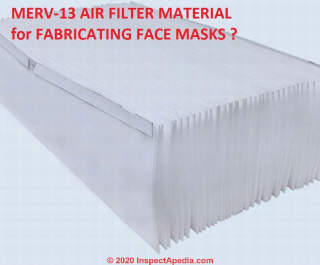
On 2020-04-14 - by (mod) - How to detect N95 "Fakes" - Counterfeit Respirators / Misrepresentation of NIOSH-Approval
Watch out for fake masks and respirators that do not work, putting their wearers at risk. See this
COUNTERFEIT RESPIRATORS / MISREPRESENTATION of NIOSH-APPROVAL [PDF] Warning from the US CDC, retrieved 2020/05/16, original source: https://www.cdc.gov/niosh/npptl/usernotices/counterfeitResp.html
title "Counterfeit Respirators / Misrepresentation of NIOSH-Approval"
In this document NIOSH provides some simple guidelines, along with pictures, to identify N-95 fakes.
Excerpt:
- No markings at all on the filtering facepiece respirator;
- No approval (TC) number on filtering facepiece respirator or headband;
- No NIOSH markings; NIOSH spelled incorrectly;
- Presence of decorative fabric or other decorative add-ons (e.g., sequins);
- Claims for the of approval for children (NIOSH does not approve any type of respiratory protection for children);
- Filtering facepiece respirator has ear loops instead of headbands.
Below: a nylon face mask described by the vendor as 2020 Excellent Breathability & Extra Comfort, filters out bacteria, dust ,chemicals, pollen, smoke, made of nylon. Separate text refers to activated carbon filter traps and filters air molecules from viruses, flu, and bacteria.
Below is an example of the proper markings found on a real NIOSH-approved N95 respirator or face mask - source: the CDC NIOSH article cited above.
[Click to enlarge any image]
On 2020-04-13 - by (mod) - face masks are not a replacement for social distancing and hand washing.
Watch out: face masks are not a replacement for social distancing and hand washing.
On 2020-04-11 - by (mod) - how to treat contaminated respirators for re-use
CDC (https://www.cdc.gov/niosh/npptl/pdfs/ElastomericPAPR-Healthcare-508.pdf) describes treating contaminated respirators with one of two methods:
– Cleaned (neutral detergent only)
– Cleaned and disinfected (neutral detergent and disinfectant)
On average, a 4.5-log reduction was observed across all 41 surfaces tested
Cleaning alone was found to be sufficient for removing/killing influenza (Lawrence, et al.)
Dawn Errede PhD, CIH
Assistant Manager, Industrial Hygiene
Metropolitan Airports Commission
Minneapolis MN
On 2020-04-11 1 - by (mod) - US FDA link discussing the shortage of masks
 Here is a US FDA link discussing the shortage of masks
Here is a US FDA link discussing the shortage of masks
https://www.fda.gov/medical-devices/personal-protective-equipment-infection-control/faqs-shortages-surgical-masks-and-gowns
Excerpt:
"On March 24, 2020, the FDA issued an Emergency Use Authorization (EUA) for importing non-NIOSH-approved N95 respirators.
Under this EUA, among other criteria, the FDA accepts marketing authorization from Australia, Brazil, Europe, Japan, Korea and Mexico who have similar standards to NIOSH.
The FDA did not list KN95 respirators made per China's standards in this EUA because of concerns about fraudulent products listed as KN95s.
On April 3, 2020, in response to continued respirator shortages, the FDA issued a new EUA for non-NIOSH-approved N95 respirators made in China, which makes KN95 respirators eligible for authorization if certain criteria are met, including evidence demonstrating that the respirator is authentic."
On 2020-04-11 - by (mod) - Respiratory Protection During Outbreaks: Respirators versus Surgical Masks
Original Message:
Sent: 04-09-2020 11:06 AM
From: James McGlothlin
Subject: NIOSH Posting: Respiratory Protection During Outbreaks: Respirators versus Surgical Masks
Heads up: If you are struggling to sort out the differences between the N-95 and Surgical Masks (not much different than our homemade masks), NIOSH has just posted a short article explaining the differences.
You can find it on this link:
blogs.cdc.gov/niosh-science-blog/2020/04/09/
NIOSH makes a clear case in the following statement: "When worn by healthcare professionals, the N-95's (NIOSH calls this class of respirators Filtering Facepiece Respirators (FFR's), are designed to protect the wearer and surgical masks are designed to protect the patient."
This NIOSH blog can be expanded to apply to our current COVID-19 pandemic and the general public and non-healthcare workers:
It you assume the principles of protection from the surgical mask apply it to our homemade masks, the statement: …surgical masks are designed to protect the patient.., this can be interpreted to mean that when you wear your homemade mask (or surgical mask if you are fortunate to have one), in public you are protecting them, and if they are doing the same in protecting you by wearing their mask.
The surgical mask (and your homemade mask) is not bullet proof in protecting each other from COVID-19 but it does offer a measure of protection, in addition to wearing disposable gloves in public, social distancing, and hand hygiene. It all adds up. NIOSH, thank you for posting this important information.
James D. McGlothlin, MPH, Ph.D., CPE, FAIHA
Purdue Univeersity
Professor Emeritus of Health Sciences
McGlothlin Ergonomics and VEM Systems, LLC
Grand Rapids, Michigan
...
Continue reading at AIR FILTER EFFICIENCY or select a topic from the closely-related articles below, or see the complete ARTICLE INDEX.
Or see these
Recommended Articles
- AIR CLEANER PURIFIER TYPES
- AIR FILTER CLEANER EFFECTIVENESS the effectiveness of indoor air cleaners & purifiers & filter systems
- AIR FILTER EFFICIENCY Analysis of the Effectiveness of Air Filters on HVAC Systems - HEPA & MERV Ratings.
- AIR FILTER MATERIAL RE-PURPOSED for FACE MASKS
- AIR FILTER OPTIMUM INDOOR
- AIR POLLUTANTS, COMMON INDOOR
- AIR POLLUTANTS, HEALTH EFFECTS
- AIRBORNE PARTICLE SIZE DEFINITIONS & TYPES
- AIRBORNE PARTICLE SIZE TABLE
- ALLERGEN TESTS for BUILDINGS
- ALLERGY & MOLD IAQ PRODUCTS
- BIOLOGICAL POLLUTANTS
- FIBERGLASS & AIR FILTERS - don't make a COVID-19 face mask that has you breathing in fiberglass dust
- INDOOR AIR QUALITY IMPROVEMENT GUIDE - home
- OZONE GENERATOR EFFECTIVENESS for INDOOR AIR POLLUTION
Suggested citation for this web page
AIR FILTER MATERIAL RE-PURPOSED for FACE MASKS at InspectApedia.com - online encyclopedia of building & environmental inspection, testing, diagnosis, repair, & problem prevention advice.
Or see this
INDEX to RELATED ARTICLES: ARTICLE INDEX to BUILDING INDOOR AIR QUALITY IAQ
Or use the SEARCH BOX found below to Ask a Question or Search InspectApedia
Or see
INDEX to RELATED ARTICLES: ARTICLE INDEX to AIR CLEANERS FILTERS PURIFIERS
Or use the SEARCH BOX found below to Ask a Question or Search InspectApedia
Ask a Question or Search InspectApedia
Try the search box just below, or if you prefer, post a question or comment in the Comments box below and we will respond promptly.
Search the InspectApedia website
Note: appearance of your Comment below may be delayed: if your comment contains an image, photograph, web link, or text that looks to the software as if it might be a web link, your posting will appear after it has been approved by a moderator. Apologies for the delay.
Only one image can be added per comment but you can post as many comments, and therefore images, as you like.
You will not receive a notification when a response to your question has been posted.
Please bookmark this page to make it easy for you to check back for our response.
IF above you see "Comment Form is loading comments..." then COMMENT BOX - countable.ca / bawkbox.com IS NOT WORKING.
In any case you are welcome to send an email directly to us at InspectApedia.com at editor@inspectApedia.com
We'll reply to you directly. Please help us help you by noting, in your email, the URL of the InspectApedia page where you wanted to comment.
Citations & References
In addition to any citations in the article above, a full list is available on request.
- National Air Filter Association, Al Veeck, Executive Director, PO Box 68639,
Virginia Beach, VA 23471
Tel: 757.313.7400 Fax: 757.497.1895; Email: nafa@nafahq.org - comments by email December 2010. Quoting from the association's website:
The National Air Filtration Association (NAFA) is the trade association for the air filter industry and is comprised of individuals and companies engaged in the sale, service and manufacture of air filtration products, worldwide. The Mission Statement of NAFA is "To conduct education and certification programs for members and end-user personnel; to provide forums for the exchange of information about technical standards, government regulations and product information; to educate end-users about the importance of air filtration and NAFA's certifications; to certify air filtration products; to set field performance standards for products; and to explore ways to increase business for NAFA members. - US EPA article on air filter efficiency: epa.gov/iaq/pubs/airclean.html 08/03/2010
- Ratib Bakera is member of Refrigeration Service Engineers Society (RSES), an International training organization for the HVACR industry provides educational and certification programs to HVACR professionals of all experience levels. www.rses.org provides information on the organization and its training materials. Independent testing and certification of HVAC technicians is provided by North American Technician Excellence - NATE - see www.natex.org. NATE is supported by ASHRAE, the US EPA, and a host of other trade and professional associations.
- Our recommended books about building & mechanical systems design, inspection, problem diagnosis, and repair, and about indoor environment and IAQ testing, diagnosis, and cleanup are at the InspectAPedia Bookstore. Also see our Book Reviews - InspectAPedia.
- In addition to citations & references found in this article, see the research citations given at the end of the related articles found at our suggested
CONTINUE READING or RECOMMENDED ARTICLES.
- Carson, Dunlop & Associates Ltd., 120 Carlton Street Suite 407, Toronto ON M5A 4K2. Tel: (416) 964-9415 1-800-268-7070 Email: info@carsondunlop.com. Alan Carson is a past president of ASHI, the American Society of Home Inspectors.
Thanks to Alan Carson and Bob Dunlop, for permission for InspectAPedia to use text excerpts from The HOME REFERENCE BOOK - the Encyclopedia of Homes and to use illustrations from The ILLUSTRATED HOME .
Carson Dunlop Associates provides extensive home inspection education and report writing material. In gratitude we provide links to tsome Carson Dunlop Associates products and services.


